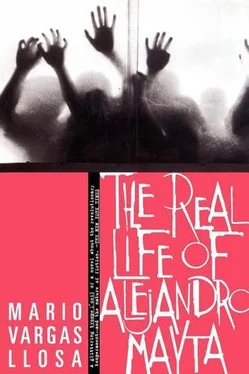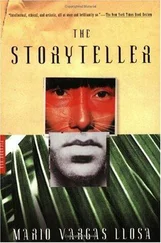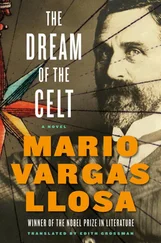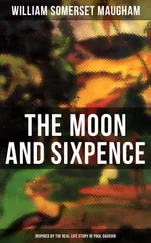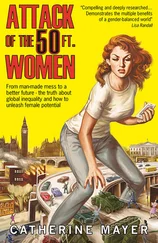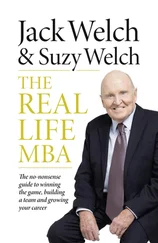Mario Llosa - The Real Life of Alejandro Mayta
Здесь есть возможность читать онлайн «Mario Llosa - The Real Life of Alejandro Mayta» весь текст электронной книги совершенно бесплатно (целиком полную версию без сокращений). В некоторых случаях можно слушать аудио, скачать через торрент в формате fb2 и присутствует краткое содержание. Год выпуска: 1998, Издательство: Farrar, Straus and Giroux, Жанр: Современная проза, на английском языке. Описание произведения, (предисловие) а так же отзывы посетителей доступны на портале библиотеки ЛибКат.
- Название:The Real Life of Alejandro Mayta
- Автор:
- Издательство:Farrar, Straus and Giroux
- Жанр:
- Год:1998
- ISBN:нет данных
- Рейтинг книги:4 / 5. Голосов: 1
-
Избранное:Добавить в избранное
- Отзывы:
-
Ваша оценка:
- 80
- 1
- 2
- 3
- 4
- 5
The Real Life of Alejandro Mayta: краткое содержание, описание и аннотация
Предлагаем к чтению аннотацию, описание, краткое содержание или предисловие (зависит от того, что написал сам автор книги «The Real Life of Alejandro Mayta»). Если вы не нашли необходимую информацию о книге — напишите в комментариях, мы постараемся отыскать её.
The Real Life of Alejandro Mayta — читать онлайн бесплатно полную книгу (весь текст) целиком
Ниже представлен текст книги, разбитый по страницам. Система сохранения места последней прочитанной страницы, позволяет с удобством читать онлайн бесплатно книгу «The Real Life of Alejandro Mayta», без необходимости каждый раз заново искать на чём Вы остановились. Поставьте закладку, и сможете в любой момент перейти на страницу, на которой закончили чтение.
Интервал:
Закладка:
The event that sent Mayta back to prison after the Jauja affair, twenty-one years ago, took place in La Victoria, near the street that was the shame of the neighborhood — Jirón Huatica, which literally crawled with prostitutes. Three gangsters, according to La Crónica , the only newspaper to write it up, seized a garage where Teodoro Ruiz Candia had an auto-repair shop. When he came to open up at eight in the morning, he found three armed men waiting for him. They also captured Ruiz Candia’s assistant, Eliseno Carabías López. The objective of these criminals was the Banco Popular. At the rear of the garage, there was a window that opened onto a lot; the rear door of the Banco Popular opened onto the same lot. Every day at noon, a van went into the lot, to take away the day’s deposits, to bring them to the Central Bank, or to deliver money to the branch for the day’s transactions. Until noon, the thieves remained in the shop with their two prisoners. They looked out through the window and smoked. Though they wore masks, the owner and his assistant swore one of them was Mayta. They also said it was he who gave the orders.
When they heard a car motor, they jumped out the window into the lot. Actually, no shots were fired. The thieves surprised the driver and the guard and disarmed them both, just after the bank employees had placed a sealed sack containing three million soles in the van. After forcing the driver and the guard to lie face down on the ground, one of the gangsters opened the gates of the lot that led to Avenida 28 de Julio. Then he ran back to the bank van, where his other two accomplices were waiting with the loot. They sped out. Because of nerves or careless driving, the van ran over a man sharpening knives, and then smashed against a taxi. According to La Crónica , the van turned over twice and came to rest upside down. But the thieves managed to get out and run away. Mayta was captured some hours later. The article does not say whether the money was recovered, and I haven’t been able to find out if the other two were ever caught.
And I haven’t been able to find out if Mayta was ever sentenced for the robbery. A police report I was able to pull from the archives of the La Victoria precinct house more or less repeats the same information as the article in La Crónica (although the humidity has ruined the paper to such an extent that it’s difficult to make it out). There is no sign of a prosecutor’s report. In the files at the Ministry of Justice, where statistics on crime and data on criminals are stored, the event shows up most ambiguously in Mayta’s file. There is a date — April 16, 1963—when he must have been sent from the police station to prison, followed by the note “Attempted robbery of branch bank, people wounded and beaten, also forced detention, traffic accident, and attack on pedestrian,” and, finally, a reference to the court handling the matter. Nothing else. It’s possible that the prosecution was slow, that the judge died or lost his job, and that the whole case remained stuck where it was, or simply that the file was lost.
How many years did Mayta spend in Lurigancho for that? I couldn’t find that out, either. I found a registry note for his entering prison, but none for his having left. That’s another thing I’d like to ask him about. In any case, I lost track of him ten years ago when he went back to jail a second time after Jauja. On that occasion, he had a proper trial and was sentenced to fifteen years for “extortion, kidnapping, and robbery leading to the loss of life.” If the dates on the file are correct, he’s been in Lurigancho for just under eleven years.
I’ve finally arrived. I go through the usual ritual. The National Guards frisk me from head to toe, and I turn in all my identification papers, which will remain at the guardhouse until my visit ends. The warden has left orders that I am to be sent to his office. An aide in civilian clothes brings me here, after crossing a patio outside the wire fences. From here, you can see the entire prison. This is the best-maintained area, the least sordid in the place.
The warden’s office is on the second floor of a cold and crumbling building made of reinforced concrete. The office itself is tiny and contains a metal desk and a couple of chairs. The walls are completely bare, and there isn’t even a pencil or piece of paper on the desk. This warden is not the one who was here five years ago, but a younger man. He knows why I’m here and orders the guards to bring the criminal I want to speak to. He will lend me his office for the interview, since it is the only place where no one will bother us. “You’ve probably seen that here in Lurigancho there isn’t an inch of space, because of overcrowding.”
While we wait, he adds that things never work right, no matter how hard they try. Now, for example, the convicts are all riled up and are threatening a hunger strike because they think their visiting rights are being cut. It’s just not true, he assures me. It’s simply that, in order to keep tabs on the visits, the usual way drugs, alcohol, and weapons are smuggled in, he’s set visits for the women on one day and for the men the next. That way, there will be fewer people each day, and each visitor can be searched more thoroughly. If they at least could cut down on the cocaine, they would keep a lot of people from getting killed. Because of cocaine, they fight it out with knives. More than because of alcohol, money, or queers, it’s the drugs. But until now it’s been impossible to keep it out. Don’t the guards sell drugs, too? He looks at me as if to say, “Why ask what you already know?”
“You can’t stop it. No matter what control systems we devise, they always beat them. Look, by just sneaking in a few grams of coke, just once, a guard doubles his monthly salary. Do you know how much they make? So there’s nothing surprising about it. People talk a lot about ‘the Lurigancho problem.’ This place isn’t the problem. The whole country’s the problem.”
He says it without bitterness, as if it were a fact I should be aware of. He seems earnest and well-intentioned. I certainly don’t envy him his job. A knock at the door interrupts us.
“I’ll leave you with the prisoner,” he says, going to the door. “Take all the time you need.”
The person who enters the office is a skinny little guy with curly white hair and a scraggly beard, who is trembling all over. He’s wearing an overcoat that’s much too big for him. He’s got on worn-out sneakers, and his frightened eyes jump around in his head. Why is he shaking like that? Is he sick, or frightened? I can’t say a word. How can this be Mayta? He doesn’t look even slightly like the Mayta in the photos. That Mayta would be twenty years younger than this guy.
“I wanted to talk with Alejandro Mayta,” I stammer.
“That’s me,” he answers in a tremulous voice. His hands, his skin, even his hair seem vexed with disquiet.
“You’re the Mayta of the Jauja business with Lieutenant Vallejos?” I hesitatingly ask.
“No, I’m not that one,” he blurts out, realizing what’s going on. “He’s not here anymore.”
He seems relieved, as if being brought to the warden’s office entailed some danger which has just vanished. He turns halfway around and bangs on the door until it opens and the warden appears with two men. Still shaking, the curly-headed old man explains that there’s been a mistake, that I’m looking for the other Mayta. He walks out in a hurry on his silent sneakers, shaking constantly.
“Know which one he’s talking about, Carrillo?” the warden asks one of his assistants.
“Sure, sure,” says a fat man, his gray hair in a crew cut and his belly slopping over his belt. “The other Mayta. Wasn’t that one mixed up in politics?”
Читать дальшеИнтервал:
Закладка:
Похожие книги на «The Real Life of Alejandro Mayta»
Представляем Вашему вниманию похожие книги на «The Real Life of Alejandro Mayta» списком для выбора. Мы отобрали схожую по названию и смыслу литературу в надежде предоставить читателям больше вариантов отыскать новые, интересные, ещё непрочитанные произведения.
Обсуждение, отзывы о книге «The Real Life of Alejandro Mayta» и просто собственные мнения читателей. Оставьте ваши комментарии, напишите, что Вы думаете о произведении, его смысле или главных героях. Укажите что конкретно понравилось, а что нет, и почему Вы так считаете.
